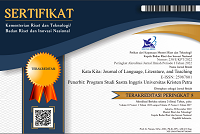ORAL CORRECTIVE FEEDBACK AND LEARNERS’ UPTAKE IN THE 5TH GRADE OF AN ELEMENTARY SCHOOL IN SURABAYA
DOI:
https://doi.org/10.9744/katakita.2.3.47-52Keywords:
Brand personality, Purchase Intention, Self-Image CongruenceAbstract
This study is a qualitative study which aimed to know oral corrective feedback and learners’ uptake in the 5th grade of an elementary school. The source of data was the teacher’s talks with the students in class and the analysis was focused on teacher’s oral corrective feedback and learners’ uptake. In order to reach the research objectives, the writer used the theory of oral corrective feedback and learners’ uptake by Panova and Lyster (2002). From the study, the writer found that five out of seven types of oral corrective feedback were used by the teacher, namely Recast, Metalinguistic Feedback, Elicitation, Explicit Correction, and Repetition. Furthermore, types of learners’ uptake following the teacher’s corrective feedback were Self Repair, Peer Repair, Repetition, Same Error, Different Error, Partial Repair and Hesitation. It can be concluded that oral corrective feedback may lead the students to show signs of learning or understanding implied in the students’ reaction to the teacher’s feedback.
References
Ajideh, P. & Aghdam, E. (2012). Journal of Academic and Applied Studies. English Language Teachers’ Corrective Feedback Types in relation to the Learners’ Proficiency Levels and Their Error Types, Vol. 2(8) & 2(9), pp. 37-51
Chaudron, C. (1977). Second language classrooms. New York: Cambridge University Press.
Brown, H. D. (2007). Principles of Language Learning and Teaching. America: Pearson Education.
Dawson, C. (2007). A practical guide to research methods: a-user friendly manual for mastering research techniques and projects (3rd ed). Oxford: How To Books Ltd.
Lyster, R. & Saito, K. (2010). Studies in Second Language Acquisition. Oral Feedback in Classroom SLA, 32, pp.265-302.
Lyster, R., Saito, K. & Sato, M. (2013). Oral corrective feedback in second language
classrooms. Language Teaching, 46, pp 140.
Oliver, R. (2000). Age difference in negotiation and feedback in classroom and pairwork. Language Learning, 50, 119-151.
Panova, I. & Lyster, R. (2002). Patterns of Corrective Feedback and Uptake in an Adult ESL Classroom. TESOL Quarterly, Vol. 36, No. 4 (Winter, 2002), pp. 573-595.
Richards, J. C. & Schmidt, R. (2002). Longman Dictionary of Language Teaching and Applied Linguistics (3rd ed.) London: Pearson Education Limited.
Samar, R. & Shayestefar, P. (2009). Corrective Feedback in EFL Classrooms: Learner Negotiation Strategies and Uptake. Journal of English Language Teaching and Learning Year 52 No. 212. pp. 108-134
Schmidt, R., & Frota, S. (1986). Developing basic conversational ability in a second language: A case study of an adult learner of Portuguese. In R. Day (Ed.), Talking to learn (pp. 237-326). Rowley, MA: Newbury House.
Sheen, Y. (2004). Language Teaching Research. Corrective feedback and learner uptake in communicative classrooms across instructional settings, 8.3. pp. 263-300
Suzuki, M. (2005). Corrective Feedback and Learner Uptake in Adult ESL Classrooms. TESOL & Applied Linguistics, Vol. 4, No. 2. pp. 1-21.
Swain, M. (1995). Three functions of output in second language learning. In G. Cook & B. Seidlhofer (Eds.), Principles and practice in applied linguistics: Studies in honour of H.G. Widdowson (pp. 125-144). New York: Oxford University Press
Downloads
Issue
Section
License
Authors who publish with this journal agree to the following terms:- Authors retain copyright and grant the journal right of first publication with the work simultaneously licensed under a Creative Commons Attribution License that allows others to share the work with an acknowledgement of the work's authorship and initial publication in this journal.
- Authors are able to enter into separate, additional contractual arrangements for the non-exclusive distribution of the journal's published version of the work (e.g., post it to an institutional repository or publish it in a book), with an acknowledgement of its initial publication in this journal.
- Authors are permitted and encouraged to post their work online (e.g., in institutional repositories or on their website) prior to and during the submission process, as it can lead to productive exchanges, as well as earlier and greater citation of published work (See The Effect of Open Access).














